

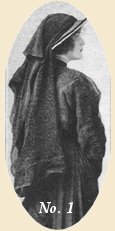
Sad times come into the lives of most of us, when a gay garb and lively colors are utterly repugnant to our every feeling. In the first effort to take up life again without some familiar presence, a natural instinct seems to bid us hide ourselves in black dress, to shield our faces in the enveloping folds of a heavy veil. And so, back of the symbolism of the crepe, there is a real reason as there is in most of our conventions. The fact that necessity compel attention to clothes in the first moments of poignant sorrow has lead many persons to revolt against the custom of wearing mourning, but while it is true that sorrow needs no outer expression, dress is, after all, a true index of feeling. Our happy moments, as well as our somber ones, have their influence upon our apparel.
It is true that we must give a more or less divided attention to the selection of a mourning hat and veil, but that does not necessarily imply that we are greatly concerned about the fashion of it. With most of us the main desire is to get something conspicuous. Such are the hats illustrated on these two pages. The shapes are notable examples of good style, an the arrangement of the veils extremely graceful and attractive. Notice the pleasing shape of the hat illustrated in figure 1. It comes forward over the forehead to shade the eyes, and frames the face in a most becoming manner. The draping of the veil is a model of grace and propriety, sweeping backward in lines which conceal any possible angularity of the back or shoulders.
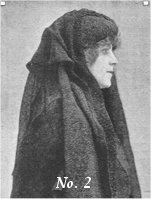
For women who must wear small hats-and there are many to who, large ones are utterly unsuited-the pretty shapes seen in illustrations No. 2 and No. 3 will suggest practical possibilities. Both of these shapes fit well down over the hair and are therefore more free than most from that uncomfortable tendency to drag, caused by the heavy veil.
The hats numbered 4 and 5 in the illustration are both larger than No. 1. They afford even better protection to the face than that graceful shape. Sloping backwards and down over the neck, they are similar to the so-called "poke" shapes we all liked so well a few years ago. The folding of the veils about the crowns of both these hats is a triumph of the milliner's art, and only skill and long practice can accomplish it with the charming perfection attained in these models. Becoming to an unusual degree are the lines of white at the edges. They relieve the somberness of the black crepe, and women who do not look well in black will find they can wear it perfectly with the touch of white near the face.
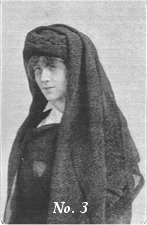
In buying your crepe, you will do well to select as good a quality as your purse will permit. You will be more than repaid for your additional outlay by the lasting wear of the better fabric. Cheap crepe succumbs soon to wind and weather and takes on a hopeless, rusty hue that proclaims to the world its poverty stricken condition, whereas for just a little more money you can get something which remains crisp and retains its color as long as you have need of it.
To buy inexpensive materials, with a view to frequent replenishing and consequent variety, which is to fit the needs of the ordinary healthy, happy life, and which changes to meet not only occasions but inclination; but mourning garments are worn for a specified period only, represent a condition of mind not occupied with constant change of wearing apparel, and it is therefore best, in buying, to buy for durability.
Even within limits of time prescribed by custom, the mourning dress is subject to much wear and tear. The question is often asked, "Why have fixed rules for something which should be so entirely a matter of the feelings alone?"
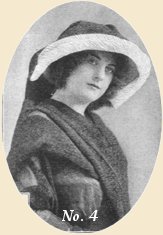
Why, indeed, but for the reason that all our customs have grown out of some real need of life. In this case we are spared many intrusions, saved from many unpleasant situations in a complicated social fabric, by a method of dress which tell to those we meet the nature of our sorrow.
Many elderly women give no heed to considerations of time, but wear for the rest of their lives the outward symbolism of the loss of one whom they were bound by the closest of ties. Some widows wear deep mourning two years, lightening it after that at periods of six months or a year. The usual rule, however, is that a widow wear her first mourning one year. The dress should be woolen or silk warp fabric of a dull black, trimmed with folds of crepe or of the material. The bonnet is a crepe, with a small white ruche about the face if desired. In former years the long crepe veil completely enveloped the head, but custom now admits a short net veil, narrowly bordered with crepe over the face, the heavy crepe veil being thrown back over the shoulders. In the second year the small bonnet may be exchanged for a black hat trimmed with crepe and a shorter veil, and in the third year it is still further lightened and the crepe is discarded. White waists may be worn for comfort with the black skirt, and even during the first year many widows permit themselves the luxury of white negligées in the seclusion of their own homes.
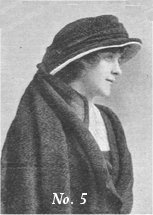
Mourning is worn two years for parents, for grown children and for brothers and sisters, although is less heavy than that worn by widows. Often only plain black is chosen, without veil, but with crepe toque or black hat trimmed with crepe. Parents wear mourning for one year for a child, and for relatives black may be worn six months and black and white for the rest of the year. Young children seldom wear mourning other than a black sash, perhaps with white dresses. But all white is more appropriate than black as mourning for the very young.
Note:This article was taken from a 1912 issue of McCall's Magazine. The techniques describe here have not been tried, and therefore Across the Ages cannot vouch for their work-ability. The instructions and/or patterns provided here are for your own use only, and may not be reproduced in any form for sale or commercial use.
Please contact the webmaster if you are experiencing any technical difficulties with this site.
About
Additions
Articles
FAQ
Feature
Links
Poll
Reviews
Resources
Sewing
©2003 Across the Ages